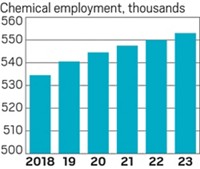Advertisement
Grab your lab coat. Let's get started
Welcome!
Welcome!
Create an account below to get 6 C&EN articles per month, receive newsletters and more - all free.
It seems this is your first time logging in online. Please enter the following information to continue.
As an ACS member you automatically get access to this site. All we need is few more details to create your reading experience.
Not you? Sign in with a different account.
Not you? Sign in with a different account.
ERROR 1
ERROR 1
ERROR 2
ERROR 2
ERROR 2
ERROR 2
ERROR 2
Password and Confirm password must match.
If you have an ACS member number, please enter it here so we can link this account to your membership. (optional)
ERROR 2
ACS values your privacy. By submitting your information, you are gaining access to C&EN and subscribing to our weekly newsletter. We use the information you provide to make your reading experience better, and we will never sell your data to third party members.
Business
Job Boom From Shale Gale
Employment: Trade group says shale gas will add more than 500,000 permanent positions
by Alexander H. Tullo
May 27, 2013
| A version of this story appeared in
Volume 91, Issue 21

Inexpensive natural gas from shale will not only bring big profits to U.S. chemical makers but will also be a boon to local communities where future chemical plant workers will live and shop, creating more than a half-million new jobs overall. That’s the conclusion of a new study by the American Chemistry Council, a trade association of chemical companies.
The job numbers seem reasonable, says Terry L. Clower, director of the Center for Economic Development & Research at the University of North Texas, who reviewed the study for C&EN.
Natural gas companies have learned to exploit shale by using sometimes controversial techniques such as horizontal drilling and hydraulic fracturing. The new gas has rejuvenated the U.S. chemical industry with cheap feedstocks, making the U.S. one of the world’s most economically advantageous places to build petrochemical and polymer chemical plants.
To quantify the impact of new investment on the broader economy, ACC economists compiled a list of 97 chemical projects that are taking advantage of shale gas. The new plants are expected to add $66.8 billion in annual production of chemicals such as ethylene and polyvinyl chloride by 2020, a 9% increase over the baseline case of a world without shale.
Chemical plant construction will require an additional 1.2 million work years’ worth of temporary jobs in construction, equipment, and building supplies, according to ACC.
In the longer term, the chemical companies responsible for the plants will directly employ 46,000 more workers than baseline. The economists also used models to project that additional raw materials and services for the plants will lead to 264,000 indirect new jobs. They say the annual payroll of these employees will total $23.8 billion, a sum that should support yet another 226,000 new jobs.
North Texas’ Clower notes that big plants have economic ripple effects. “Because of all the spending that goes along with them, the indirect jobs are pretty big oftentimes,” he says. The plants “don’t create lots of jobs themselves because they are largely automated facilities.” He adds that high indirect jobs multipliers are normal for chemical plants and refineries.





Join the conversation
Contact the reporter
Submit a Letter to the Editor for publication
Engage with us on Twitter